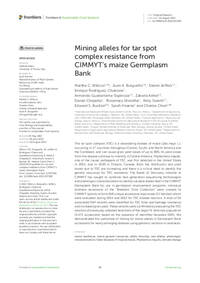Mining alleles for tar spot complex resistance from CIMMYT's maize Germplasm Bank

Authors:
The tar spot complex (TSC) is a devastating disease of maize (Zea mays L.), occurring in 17 countries throughout Central, South, and North America and the Caribbean, and can cause grain yield losses of up to 80%. As yield losses from the disease continue to intensify in Central America, Phyllachora maydis, one of the causal pathogens of TSC, was first detected in the United States in 2015, and in 2020 in Ontario, Canada. Both the distribution and yield losses due to TSC are increasing, and there is a critical need to identify the genetic resources for TSC resistance. The Seeds of Discovery Initiative at CIMMYT has sought to combine next-generation sequencing technologies and phenotypic characterization to identify valuable alleles held in the CIMMYT Germplasm Bank for use in germplasm improvement programs. Individual landrace accessions of the “Breeders' Core Collection” were crossed to CIMMYT hybrids to form 918 unique accessions topcrosses (F1 families) which were evaluated during 2011 and 2012 for TSC disease reaction. A total of 16 associated SNP variants were identified for TSC foliar leaf damage resistance and increased grain yield. These variants were confirmed by evaluating the TSC reaction of previously untested selections of the larger F1 testcross population (4,471 accessions) based on the presence of identified favorable SNPs. We demonstrated the usefulness of mining for donor alleles in Germplasm Bank accessions for newly emerging diseases using genomic variation in landraces.
